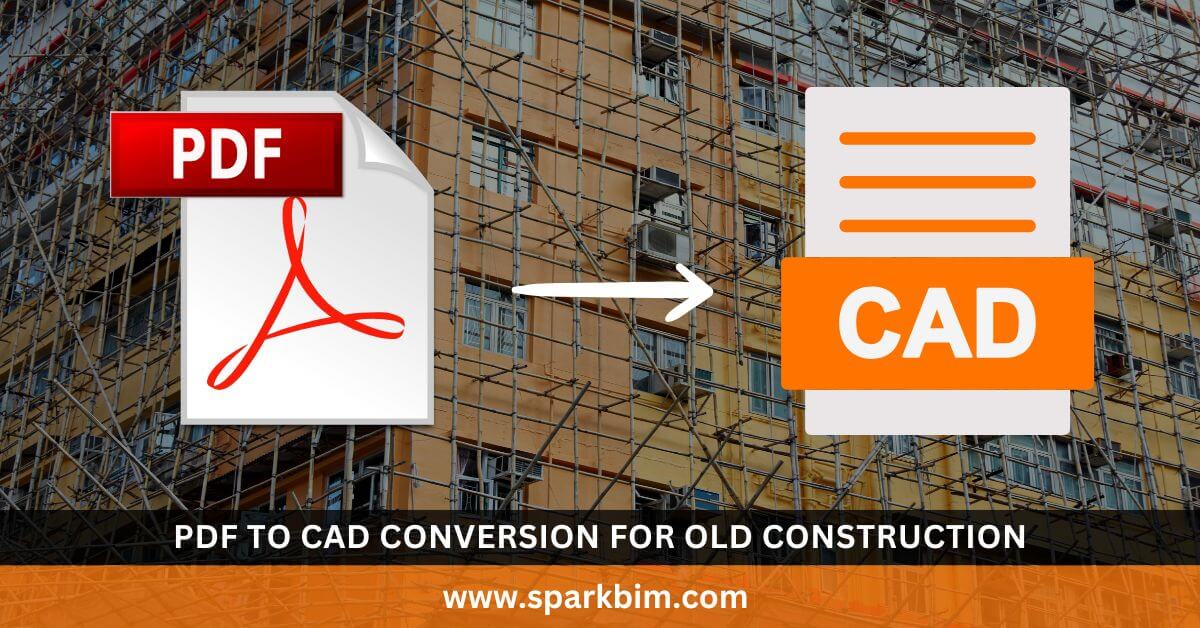Table of Contents
ToggleIn the construction industry, maintaining accurate and up-to-date plans is crucial for the smooth execution of projects. Over time, older construction projects may have outdated plans or even physical drawings that no longer meet modern building requirements.
One of the most effective ways to breathe new life into these old construction plans is through PDF to CAD conversion. This process transforms scanned or digitally created PDF files into editable CAD drawings, allowing for more straightforward modifications, updates, and improvements.
In this blog post, we’ll explore why PDF to CAD Conversion for old construction projects is essential, how it works, and how it can benefit your next renovation, expansion, or new construction project.
Importance of PDF to CAD Conversion for Old Construction
Before diving into the specifics of PDF to CAD conversion for old construction projects, it’s essential to understand why this conversion is important. Many older construction projects rely on paper blueprints or PDF versions of the original designs.
However, as buildings and structures evolve, so does the need for updated plans. These updates may include structural changes, system upgrades, or modernizations to comply with new building codes and safety regulations.
PDF files are often difficult to edit and may not be compatible with current software systems or standards. On the other hand, CAD drawings are easily editable, allowing for real-time changes and precise modifications that can be directly implemented into construction workflows. Converting PDFs into CAD files offers the following key benefits:
Accuracy and Precision
CAD software enables designers to make accurate, dimensioned modifications without worrying about distortion or errors.
Editable Files
Unlike PDFs, which are static and uneditable, CAD files can be updated and altered as needed throughout the construction or renovation process.
Better Collaboration
CAD drawings are widely accepted and used by architects, engineers, and contractors, making them the preferred format for team collaboration.
Compliance with Modern Standards
CAD software ensures that your construction plans meet the latest standards, regulations, and building codes.
Process of PDF to CAD Conversion for Old Construction
The PDF to CAD conversion process involves several steps to ensure that the resulting CAD files are accurate, precise, and usable. Let’s break down the main stages of the process:
1. Preparation of the PDF File
Before conversion, it’s crucial to assess the quality of the PDF file. If the PDF is a scanned image (like a physical blueprint), it may require some cleanup, such as adjusting the contrast, brightness, and resolution.
Higher-quality scans will result in better outcomes in the conversion process. If the PDF is vector-based (created from digital designs), the conversion process is more straightforward.
2. Conversion to CAD Format
Once the PDF is ready, it’s time to convert it to CAD format. The most common formats used for CAD are DWG and DXF, which are compatible with software like AutoCAD and other CAD tools. The conversion software or service used will trace the lines and features of the PDF and recreate them as editable vectors in the CAD file.
3. Quality Check and Refinement
After conversion, a quality check is essential to ensure that all elements have been transferred accurately. Some CAD software tools can automate this process, but manual refinement is often required.
It includes adjusting dimensions, fixing misalignments, and ensuring that features such as walls, doors, and windows are properly scaled and positioned. Any missing data or distorted elements are corrected at this stage.
4. Layer Management and Finalization
In CAD drawings, different elements are usually separated into layers (e.g., plumbing, electrical, and structural elements).
The final step is organizing these layers for clarity and easy manipulation. Once the layers are set up, the CAD file is ready for use, and any future updates can be made without starting from scratch.
Also Read, CAD and BIM: Key Differences in Building Design Explained
Why PDF to CAD Conversion is Essential for Old Construction
Now that we understand the process, let’s take a closer look at why PDF to CAD conversion is especially valuable for older construction projects.
1. Updating Outdated Plans
One of the most common reasons for converting old construction PDFs to CAD files is to update outdated plans. Over time, buildings undergo renovations, expansions, and upgrades, but the original blueprints or PDFs may not reflect these changes.
Converting PDFs into CAD files allows for modifications, enabling engineers and architects to update building plans efficiently and accurately.
2. Facilitating Renovations and Expansions
For any renovation or expansion project, having up-to-date and editable plans is critical. For example, if you are adding new rooms, upgrading electrical systems, or expanding the building, you need a detailed and accurate base drawing.
CAD drawings make it easier to incorporate these changes by offering more flexibility than static PDF files. The updated plans can be used as a reference for construction, ensuring that the new addition fits seamlessly with the existing structure.
3. Reducing Errors in Construction
Old PDF files often come with a risk of errors or inaccuracies, especially if they were manually created or scanned from physical blueprints.
A PDF to CAD conversion removes the guesswork by providing an accurate, digitized, and editable version of the old plans. With precise measurements and the ability to make instant modifications, you can minimize the likelihood of errors and costly mistakes during the construction phase.
4. Improving Compliance with Modern Standards
Building codes and regulations frequently change over time. What was acceptable in the past may no longer meet current standards. When working with old construction projects, PDF to CAD conversion ensures that your drawings are not only accurate but also compliant with the latest safety regulations and construction standards.
The conversion process allows you to modify the design to meet new codes, such as adding fire safety measures or implementing energy-efficient features.
5. Improves Collaboration and Communication
CAD files are more easily shared, modified, and collaborated on by multiple stakeholders. This is particularly important for team-based construction projects where architects, engineers, contractors, and other professionals need to work together.
Converting old construction PDFs to CAD makes it easier for everyone involved in the project to access, review, and update the plans as needed. It streamlines communication, ensuring everyone is on the same page.
6. Long-Term Management and Digital Archiving
Once old PDFs are converted into CAD files, the digital files can be easily stored, managed, and archived. With the shift toward digital construction management, having CAD files on hand ensures long-term accessibility and ease of updates in the future.
Digital archiving also reduces the physical storage space required for blueprints and reduces the risk of losing important documents.
Benefits of PDF to CAD Conversion for Old Construction
Let’s recap some of the key advantages that come with converting old construction PDFs to CAD:
- Increased Flexibility: CAD files can be easily modified to meet the needs of modern construction projects, whether for renovations, expansions, or upgrades.
- Cost Savings: By improving the accuracy and reducing errors in the planning stages, you can save money on costly mistakes during construction.
- Faster Project Turnaround: The ability to quickly update and modify CAD drawings speeds up the entire design and construction process.
- Improved Accuracy: Conversion allows for precise measurements and eliminates the inaccuracies that are common in older PDF files.
- Compliance with Modern Standards: CAD files can be updated to comply with the latest building codes and regulations, ensuring that your project meets current standards.
Conclusion
PDF to CAD conversion for old construction projects is a powerful tool that modernizes outdated plans, streamlines workflows, and ensures accuracy. Whether you are working on a renovation, expansion, or new construction, having editable, up-to-date CAD drawings is essential for success.
By converting old construction PDFs into CAD files, you’ll not only improve the quality and accuracy of your designs but also enhance collaboration and compliance with modern standards.
As the construction industry continues to embrace digital tools, the importance of PDF to CAD conversion will only grow. If you’re looking to update your old construction plans, investing in this conversion process is a step in the right direction.
It is an investment in the future of your projects, ensuring that your designs are accurate, flexible, and ready for modern construction challenges.


